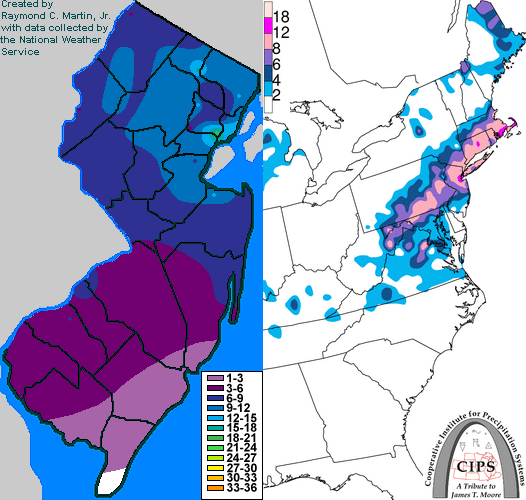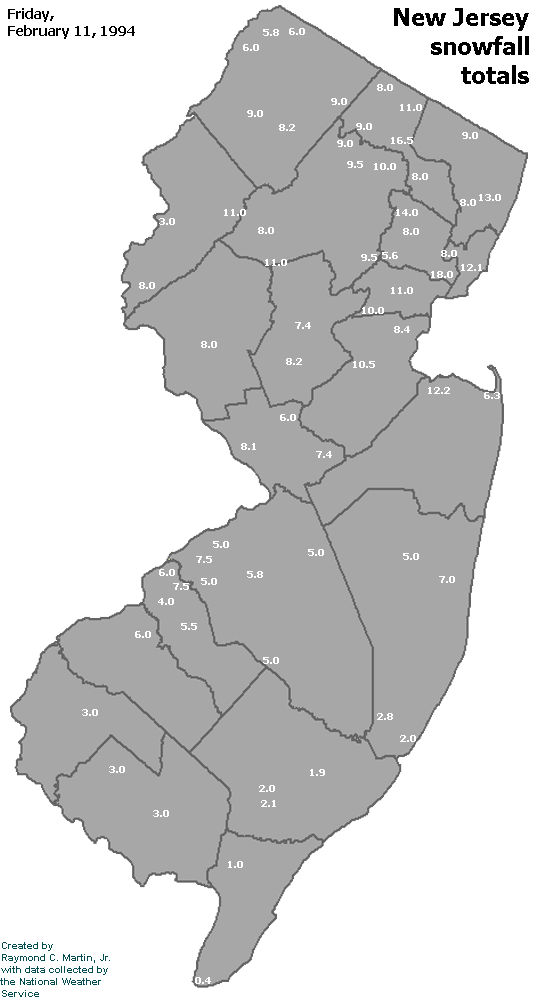

Storm description, surface observations, snowfall totals, and images courtesy of the National Climatic Data Center, the National Centers of Environmental Prediction, the Climate Prediction Center, the Hydrometeorological Prediction Center, the Mount Holly National Weather Service Office, the Upton National Weather Service Office, Rutgers University, Plymouth State University, the University of Illinois, the American Meteorological Society, Weather Graphics Technologies, AccuWeather, and the Weather Channel.
Table of Contents
Storm Summary
Regional Surface Observations
Satellite Imagery
Sea Level Pressure and 1000 to 500 Millibar Thickness Maps
850 Millibar Maps
700 Millibar Maps
500 Millibar Maps
300 Millibar Maps
200 Millibar Maps

Contoured Snowfall Totals from February 11, 1994
STORM DESCRIPTION
A low pressure system moving eastward across the Deep South brought another round of heavy snow and ice to most of New Jersey. Across much of northern and central New Jersey, this was the heaviest snowstorm of the winter.
Synoptic Discussion
The same slow moving frontal boundary which brought snow and ice to New Jersey on February 8th and 9th had pushed into the Deep South and over the northwestern Gulf of Mexico by early on the 10th. A low pressure system developed along the front over the northwestern Gulf during the day on the 10th and began moving northeastward. By early on the 11th, the low pressure entered Tennessee Valley. As it did so, energy began to transfer from the first low pressure to a new low pressure developing further east along the stalled front near the Outer Banks of North Carolina. This second low became the primary low by the evening of the 11th. By the morning of the 12th, the first low pressure had dissipated while the second low pressure had moved well east of the Mid-Atlantic Coast.
Local Discussion
Precipitation overspread the state from south to north during the night of February 10th. Across most of southern New Jersey, it began briefly as snow before quickly turning to sleet and freezing rain as warm air moved in aloft. Further north across central New Jersey, snow fell at a moderate to heavy rate through the morning of the 11th before changing to sleet during the afternoon. Across northern New Jersey, precipitation remained primarily in the form of snow, which also fell at a moderate to heavy rate during the morning hours before lessening in intensity somewhat during the afternoon. Precipitation tapered off from west to east during the evening of the 11th. Accumulations were highest across northeastern New Jersey where they ranged from 6 to 18 inches. Across northwestern New Jersey, accumulations averaged 4 to 12 inches, while across central New Jersey they averaged 5 to 10 inches. Across southern New Jersey, where more sleet fell than snow, total accumulations of both snow and sleet averaged from 1 to 4 inches. Ice accrual from freezing rain was rather light, with up to 1/4 inch across the far south.
New Jersey Snowfall Totals

Individual Snowfall Totals from February 11, 1994
Table of Contents
Storm Summary
Regional Surface Observations
Satellite Imagery
Sea Level Pressure and 1000 to 500 Millibar Thickness Maps
850 Millibar Maps
700 Millibar Maps
500 Millibar Maps
300 Millibar Maps
200 Millibar Maps
Snow storm, December 29-30, 1993
Ice storm, January 3-4, 1994
Ice storm, January 7-8, 1994
Snow and ice storm, January 17-18, 1994
Snow storm, January 25-26, 1994
Snow and ice storm, February 8-9, 1994
Snow and ice storm, February 11, 1994
Snow and ice storm, February 23-24, 1994
Snow and ice storm, March 2-3, 1994
Snow storm, March 18, 1994
Back to Ray's Winter Storm Archive
Copyright © 2012 by Raymond C Martin Jr. All rights reserved